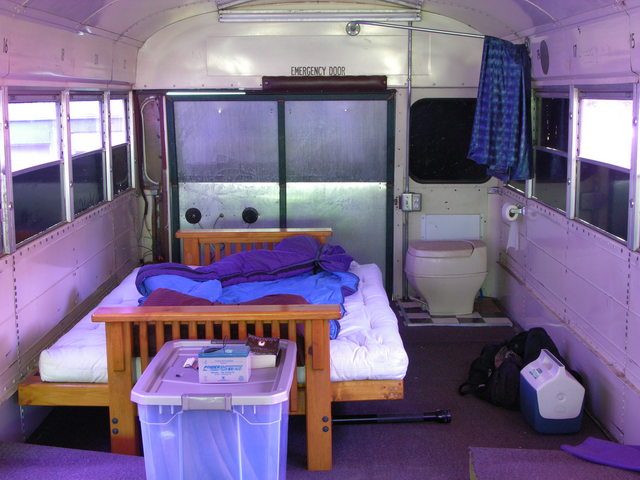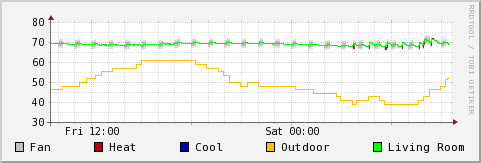I’ve just come inside from my first night sleeping in the bus. It was a trial run in my own driveway to find out whether I needed anything more than the futon, a bottle of water, and a reading light in order to spend the night. Answer: I really don’t, but I learned several important things from the experience.
Backing the Bus into the Driveway
When I had the bus parked on the street in front of my house over spring break, I noticed a lot of vehicles driving by slowing down to gawk at it. Yes, it was a large obstacle parallel-parked on the street; but you can tell the difference between slowing down to get around an obstacle safely and slowing to a crawl, sometimes stopping altogether, head(s) turned to look.
Friday of that week, the police chief stopped by to visit with me about the bus. My mother worked for him when she was city office receptionist and court clerk, he’s an old friend of the family, and he’s very considerate, so this was not a stressful experience for me like it could be for some.
He came with several issues:
- You can’t park a big purple bus on the street in front of your house. It creates a traffic hazard.
- We’ve been receiving complaints.
- This license plate is expired and belongs to a 1986 Chevy and you can’t move another license plate onto a bus like that.
I explained that I had the bus there to work on during spring break and that I was planning to take it back the next day, that it really is a 1986 Chevy, and that it really is currently tagged and insured but I haven’t been able to find the 2012 sticker for the license plate.
He was satisfied and sought nothing further from me; but before bringing the bus home yesterday (having initially thought I’d park it on the street overnight), I contacted the city administrator, another old acquaintance whom I deeply admire. He replied,
If your converted bus is lawfully registered, tagged, and operable, you can park it on the street. We would prefer that you don’t because it causes congestion and a potential traffic hazard. Will rely on your good sense to decide.
I appreciate the direct yet polite approach and resolved to do what I could to keep the bus off the street — which meant backing it into my driveway.
I frequently backed the bus onto the concrete pad at my brother’s property, parallel parking close to the shed — but that has a long approach and plenty of room to correct.
With the long distance behind the rear axle and the broken right-side wide-angle mirror, I was concerned about getting my angle right to back into our single-car driveway. With the long distance behind the rear axle, the doesn’t-seem-steep-in-a-car driveway and crown of the street, and my experience gouging the street with the back of the bus backing it out of my driveway, I was concerned about scraping on the way in.
The solution to both problems was getting the back wheels onto the corner of the “alluvial fan” at the bottom of my driveway while the bus was still angled, then straightening quickly. And this required a better view of the right rear wheels than I thought I had available — but I practiced backing the S-curve into my brother’s alley near where the bus parks and that went well. At home on my own driveway, I got the wheels almost exactly where I wanted them and pulled forward a bit to straighten once, though I think I wouldn’t have had to.
Lesson learned: Backing the bus takes less practice, on top of my experience backing other moderately large vehicular combinations, than I had guessed.
Preparing for Night
With the bus in position, I started readying it to sleep in. The futon had been folded flat into a queen bed and I folded it back up to a couch/twin, to see whether it would work for me to sleep on while taking up less floor space. I brought out my sleeping bag, pillow, and book, and I set up a makeshift lantern out of a secondhand 12V AGM battery and an LED panel so I’d have a reading lamp that (A) wouldn’t drain the bus’s starting battery and (B) I could turn off when I was ready to sleep without getting out of bed to go to the switch panel at the front of the bus.
All of the purple except the sleeping bag is from the window tint, of course.
Futon and Slope
Most of this arrangement worked well, but I quickly found myself dissatisfied with the slope of the futon bench and got up to lay it flat into a queen bed again. This was an extremely important finding, because one of the things I most wanted to learn from this trial run was how I’d react to the bus being parked on non-level ground.
Purpose-built RVs have hydraulic jacks to level the RVs and stabilize them from rocking while parked. The bus doesn’t have levelling jacks, and I’ve wondered whether I’d need to add some — whether I’d mind it being parked on a slope or rocking while guests are moving around in it. The angle of the futon seat is steeper than that of any slope I’m likely to park on — but given my discomfort, I think I should at least look into the stackable levelling shims that you can set in front of your wheels and drive onto.
Lessons learned: Don’t sleep on the futon in couch configuration. Look for some means to level the bus when parked for night.
Kerosene
At some point during the night, I thought I noticed a smell of diesel fuel inside the bus, which doesn’t make much sense as it has a gasoline engine. This morning I figured out the only likely cause — the futon was in storage next to an armchair my uncle and aunt discarded after a kerosene jug leaked onto it during their interstate move (and my brother thought he might eventually want the chair). Easy enough — finish cleaning the futon mattress and wait it out. I also keep a package of eucalyptus in the bus and rather like the smell it imparts, even two years old.
Lighting
I’ve previously used the bus’s dome lights for work lighting in the evenings and noticed them getting considerably dimmer as the evening wore on and they drained the (not huge) battery. That’s why RVs have separate starting and house batteries; but I haven’t yet set up a house battery and separate wiring.
My LED reading lamp worked very well. After an ice storm, I had previously used the same LED panel with a smaller, 7.5 Ah battery and left it shining all night with minimal dimming, so I expected good results from the lamp. It doesn’t provide as much overall illumination as the dome lights — but I intended it for task lighting, and it performed admirably. This validates my plan to use warm white LED spotlights for reading lamps.
Lesson learned: LED lamps are easily bright enough for reading and impose much less drain on the battery than the dome lights.
Outside Noise and Light
I heard quite a bit of noise from cars driving by, and once from people walking by, until I fell asleep. I actually got up at one point thinking I must have left a window open, but it was not the case. I’m surprised how little the bus attenuates external noise, and I’m not sure it’s practical to cut that down much.
Lesson learned: If parking in town, be prepared for city noises.
I also had a fair bit of light shining in, from our porch light, the neighbors’ driveway light, and cars driving by on the street. It didn’t bother me much and I’ve already intended to replace the purple window tint with mini-blinds, which give a wider range of choices for view and darkness, but it could bother some guests.
Lesson learned: Until I install blinds and a windshield screen, be prepared for light at night.
Futon, the Morning After
I normally sleep on a (firm) waterbed, and when I sleep in hotel beds or on friends’ floors in a sleeping bag, my hip joints usually hurt by morning. Sleeping on the futon was no exception; so for my own comfort, it’s fairly important to build a dedicated bunk with the right cushion for me.
This will suit my purposes anyway, as the futon is wide, taking up fully half the width of the bus even in couch configuration, and angled, making it difficult to secure to the wall for travel. A slim bunk firmly attached to floor, wall, and ceiling will meet my needs and take less space.
Lesson learned: Building a bunk will probably make the most difference for my next night in the bus.
Chilly
The orange line is the outdoor temperature, pulled from the nearest METAR station; it was about 40°F when I woke up. Outside and in the bus. And I like it. And my friends most likely to travel with me like it. And I hope to travel mainly in cool spring and fall, plus to cool altitudes, so I can expect a lot of it.
But not everyone would like it. And I know the windows rattle and don’t seal well. And the floor is thin, though the carpet helps some. One can always open windows if it’s too much warmer inside than out, so it’d be nice to tighten it up a bit. On the other hand, for this bus and how I want to use it, I don’t think a full-scale insulation job is worth the effort.
Lesson learned: Improve the weather sealing wherever feasible.

